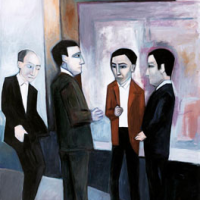48. ROBERT DICKERSON

The death of Robert Dickerson in October 2015 took many people by surprise. It was not that his death at the age of ninety-one was particularly unexpected, even if he had been in robust health for the preceding few years, but it was because Dickerson was a maverick and unique figure in the Australian art scene for decades. It is difficult to imagine Australian art without his candour, possum-stirring humour and brilliant and evocative images that stay forever in the popular imagination.
He was born in Hurstville in 1924 and spent his childhood against the background of the Great Depression in Sydney. From an early age he drew compulsively, but from his early teens worked in factories and earned money as a professional boxer. With the outbreak of the war, he enlisted and served for four years in the Royal Australian Air Force and on being demobilised turned seriously to painting and started to exhibit in the late 1940s.
He was passionate and prolific and early success exposed his weaknesses with bouts of heavy drinking accompanied by mediocre paintings, a couple of failed marriages and five children. He was the only Sydney-based artist to participate in Bernard Smiths Antipodean exhibition held in Melbourne in August 1959, sensing that his art seemed to have a greater affinity with the figurative artists of Melbourne, than in his home town. In Melbourne he found support from the patrons, John and Sunday Reed, as well as the art historian, Bernard Smith, and formed a friendship with the artists John Brack (1920-1999), Arthur Boyd (1920-1999) and Charles Blackman (1928-2018).
In 1969 Dickerson moved to Brisbane, where in the house of Charles and Barbara Blackman he met his future wife, the poet Jennifer ne Phillips, who became a stabilising and sobering influence on his life. Together they travelled abroad on several occasions and finally settled in Nowra on the South Coast of New South Wales, where he combined his passion for horses with painting, within a quiet rural retreat. Jennifer Dickerson reflecting on his path in life and art, observed He has been swimming against the tide all of his life. It keeps him strong. The occasions when he has been going with the flow brought him intense discomfort; he felt he was weakening himself, and his art, and he knew adversity was a true friend.1
Dickerson is an artist whose work is dominated by recurring themes, including alienated children, sensuous lovers, jockeys, the harlequin, lonely clerks and office workers, displaced peoples although these images may have their origins in the specifics of Dickersons biography, their precious quality is that touch of otherness, a dreaminess which seems to speak of other realities. Conference in the Street, is a classic expression of urban alienation. The four awkwardly posed suited men meet in an ambiguous space, as if on a circular stage, but within an urban setting, and they appear to speak to one another without actually communicating. Each person is isolated within his own pocket of space, despite their close physical proximity. The subdued palette, the heavily stylised faces and the uniformity of their attire suggests a certain sameness about these figures.
What is this street conference about? Is it about art or the state of the banking sector, the sporting world or a legal contest? We are provided with very few clues and the only certainty is that this conference will not resolve anything and that this is a timeless and eternal ritual that is part of the human condition.
In the final analysis, the effectiveness of Robert Dickersons paintings lies in their ability to convey a situation, which is common to many people and to convey this with an unforgettable visual lucidity.
Footnotes
1. Dickerson, J., Robert Dickerson: Against the tide, Brisbane, Pandanus Press, 1994, p.4
Emeritus Professor Sasha Grishin AM, FAHA